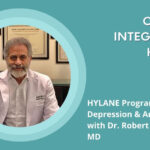High Rate of Thyroid Dysfunction in Non-ill
According to a very large study, the NHANES study (see reference below), conducted over 10 years, there is “a high rate of thyroid dysfunction in the general “non-ill” population (5.9%)*.
Thyroid Dysfunction and Affective Disorders
There is an increased rate of thyroid dysfunction in those with affective disorders (40%)** Additionally the mean TSH , in the healthy adult U.S. population is 1.4 units. Because the commonly cited reference range at most laboratories is very wide (about 0.5 to 4.5), there is considerable debate about whether this normal reference range is too wide.
Endocrinologists’ Disagreement
There is disagreement among endocrinologists around this issue, with one camp wanting to narrow the range to 0.5 to 2.5 units. For people with psychiatric problems the index of suspicion must be much higher because thyroid hormone (specifically t3, known as tri-iododthyronine) is necessary for normal serotonergic and noradrenergic function.
Onset of Hypothyroidism
Onset of hypothyroidism is usually quite insidious, and signs and symptoms are nonspecific (e.g., can present as depression, ADD, insomnia, fibromyalgia, Chronic Fatigue Syndrome etc.) and usually overlooked. Many psychiatric medications require adequate thyroid hormone to function properly, and even gastrointestinal absorption of nutrients is reduced by hypothyroidism.
References
*Hollowell JG. Et al.: Serum TSH, T4, and thyroid antibodies in the United States population (1988-1994): National Health and Nutrition Examination Survey (NHANES III). J. Clin Endocrinol Metab 2002 Feb;87 (2) 489-99.
** Hein MD. Et al.: Review: Thyroid Function in Psychiatric Illness. General Hospital Psychiatry 12. 232-244. 1990




